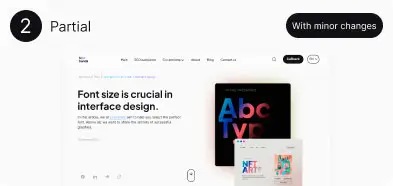Duplicate pages on website: How to avoid them and influence SEO
One of the worst enemies of SEO promotion is duplicate pages or content on them. It immediately affects the authority of your website in the eyes of both search engines and users. That’s why today we’re going to talk about how duplicate content occurs, how to fix it, and how to avoid this mistake if possible.



Definition of the term “duplicate pages”
What are duplicate pages? If you open the Google glossary, it says that this is a phenomenon in which the same or similar content is repeated on different pages of the same site or different pages. It should not be confused with quoting parts of the text in other articles, because this type of linking is encouraged by Google, as it shows the expertise and authority of your information.


Types of duplicate pages


Duplicate pages can be exact or partial.
In the first case, the content is completely copied, meaning that text, images, videos, and other elements from one page are duplicated on another. Another feature of this type is duplication of HTML code, including meta tags, headings, alt attributes for images on the site. Although exact duplication is easier to detect with site analysis tools or even through simple URL comparison, it can have serious SEO consequences, such as dispersing link weights and inefficient use of crawling budgets by search engine crawlers.
On the other hand, partial duplication can be more insidious and difficult to detect. In this case, the pages may contain similar but not identical content, with minor changes in text, images, or page structure. To detect partial duplication, you need to conduct a thorough site SEO audit using content analysis tools that can compare text, structure, and other elements of the pages. This can be a time-consuming process, especially for large websites with thousands of pages. However, identifying and eliminating partial duplicates is important for improving your site’s SEO performance and providing a better user experience.


Causes of duplicate pages
Technical errors:
- Incorrect server configuration or redirects
- Using multiple protocol versions (HTTP/HTTPS) without proper redirection
- Using different URL versions for the same page (for example, with / or without / at the end of the URL)
- Errors in the caching system or the use of multiple servers without synchronization
Human errors:
- Copying and pasting content without creating unique text
- Creating multiple pages with the same or very similar content
- Incorrect use of canonical tags or robots meta tags
- Non-compliance with the rules of internal linking and creation of several links to one page with different URLs
Generation of duplicate content by a content management system (CMS):
- Automatically create archive, tag, or category pages with the same content
- Generate separate pages for each combination of filters or sort options
- Creating multiple versions of a page for print or mobile devices without properly labeling the main version


The importance of avoiding duplicate content for SEO
Originality and uniqueness of content are among the key factors that Google and other search engines take into account when indexing and ranking pages. This is not only a matter of reliability and expertise of the information, but also its value for users. Duplicate content can seriously undermine the trust of search engines in your website and negatively affect its visibility.
Let’s take a look at the possible consequences of not noticing and correcting duplicate content on your website in time:
- Confusion for search engines: When crawlers find the same content on multiple pages, they cannot determine which one is the original and most relevant to the user’s query. This can lead to the fact that none of these pages will be shown in the top search results.
- Decrease in website authority: duplicate content can be perceived by search engines as an attempt to manipulate search results or as a sign of low website quality. This can lead to a decrease in the credibility of your site in the eyes of search engines and negatively affect its overall ranking.
- Loss of potential customers: if your pages do not reach the top positions in search results due to duplicate content, you lose the opportunity to attract potential customers to your site. Users simply won’t be able to find your information or products because your pages will be hidden behind competitors’ results.
- Negative impact on user experience: even if a user lands on your site, duplicate content can cause confusion and irritation. Users may think they’ve landed on the same page twice, or that the site contains low-quality, repetitive information. This can lead to a high bounce rate and reduced time on site, which are negative signals for search engines.
- Risk of penalties: in some cases, especially when duplicating content from other sites or using automatically generated content, your site may be penalized by search engines. This can lead to a decrease in the visibility of your site in search results or even to its exclusion from the index.

Increase visibility
for your business: SEO solution for growth!


How to detect duplicate pages
It is impossible to predict when duplicate pages may appear, so you need to regularly audit your site to detect such an error. However, how exactly can you find and check your resource for unexpected data duplication? There are several methods and tools for detecting duplicate pages on a website.
- Google search
- You can use the “site:” operator to search within your domain, for example, site:example.com. You need to add unique phrases or sentences from your content in quotation marks to the search query to find pages with identical content.
- Monitoring Google Analytics reports
- Pages with high bounce rates or low dwell times may indicate possible duplicate pages or pages with low-quality content. You can check them using reports from the Google Analytics tool.
- Analyze internal link reports
- Tools like Ahrefs or Moz can be used to analyze the internal link structure of your website. To find pages with the same or very similar names and URLs that may indicate duplicate links.
- Manually check for suspicious pages
- You can manually review pages for suspected identical or similar titles, meta tags, or parts of content. This process is more time-consuming but also more accurate. You can also use a plagiarism checker service to detect external duplicates or cases of copying your content by other sites and know what to do about it.
Once duplicate pages have been identified, it is important to take certain steps to eliminate them, which we will discuss below.


How to eliminate duplicate pages
So we’ve figured out why duplicate content is a problem for search engines and understood where and how to look for duplicate pages, now we need to figure out how to fix this problem so that there are no consequences from search engines. Eliminating duplicate pages is an important step to optimize your website and improve its SEO performance. Here are some effective methods of dealing with duplicate pages:
- Use 301 redirects
- Determine the canonical, i.e. the main version of the page and redirect all duplicate pages to it using a 301 redirect. This will help you consolidate link weights and avoid inefficient weight splitting between duplicates. You can learn more in our article about 301 redirects: importance and settings.
- Setting up canonical tags
- You can use the <link rel=”canonical”> tag in the HTML code of each page to indicate the main version. This will help search engines determine which page to index and show in search results.
- Optimize URL parameters
- Avoid using unnecessary parameters in the URL that can create duplicates.
- Setting up robots.txt
- In the robots.txt file, you can set a rule to prevent search robots from indexing duplicate or less important pages. However, you need to be careful not to exclude important pages from indexing.
- Ensure the uniqueness of the content:
- It is important to create unique and relevant content for each page on your website to meet the needs of your target audience. Avoid copying information from other sources or creating similar pages to avoid losing the trust of both customers and search engines.
- Correct internal links:
- Internal links on your site should lead to canonical versions of pages to strengthen their weight and improve site navigation.
The process of eliminating duplicates can take some time, and the results may not be instantaneous. However, regular site audits, monitoring the appearance of new duplicates, and applying methods to avoid them will help improve the functionality and originality of your site and its search engine rankings.

Increase visibility
for your business: SEO solution for growth!


If you need help
If you suspect that your pages or content are duplicate, you can contact our specialists who will conduct a thorough audit of your site or audit of your content to check and provide recommendations for further page optimization.
You may also like it

Brand identity: The key to brand recognition and SEO success
Every product has its own unique feature that sets it apart from other brands. It could be a special font, a unique mascot, or an interesting logo with the right...

What is a dynamic URL and its impact on SEO
A dynamic URL (Uniform Resource Locator) is a web address that changes depending on the user's request or specific parameters. It differs from a static

Press releases as an important part of your SEO strategy: Brand Push Services
SEO is the best promotion on the Internet that helps attract more potential clients and improve your market position. The use of press releases is an important SEO...












